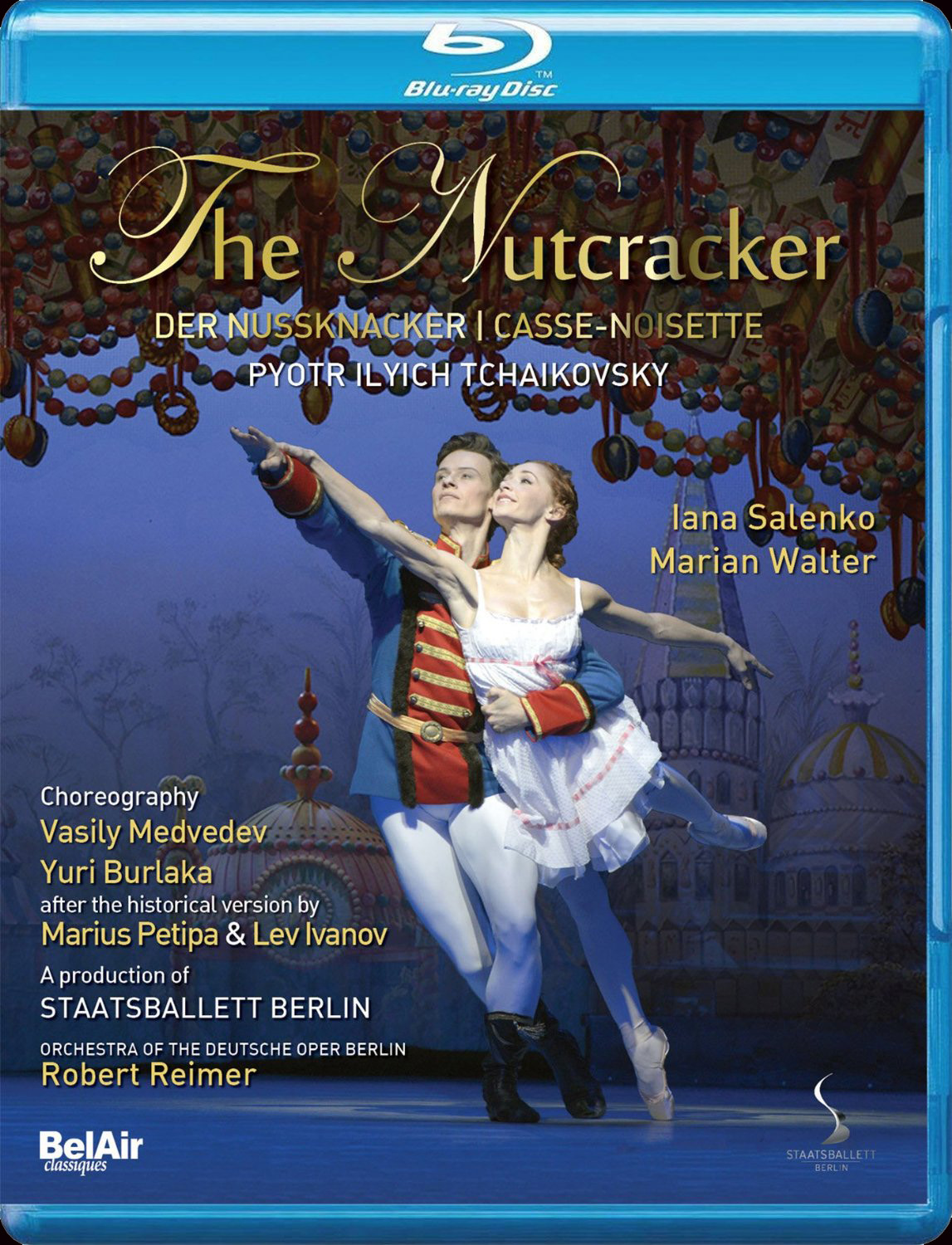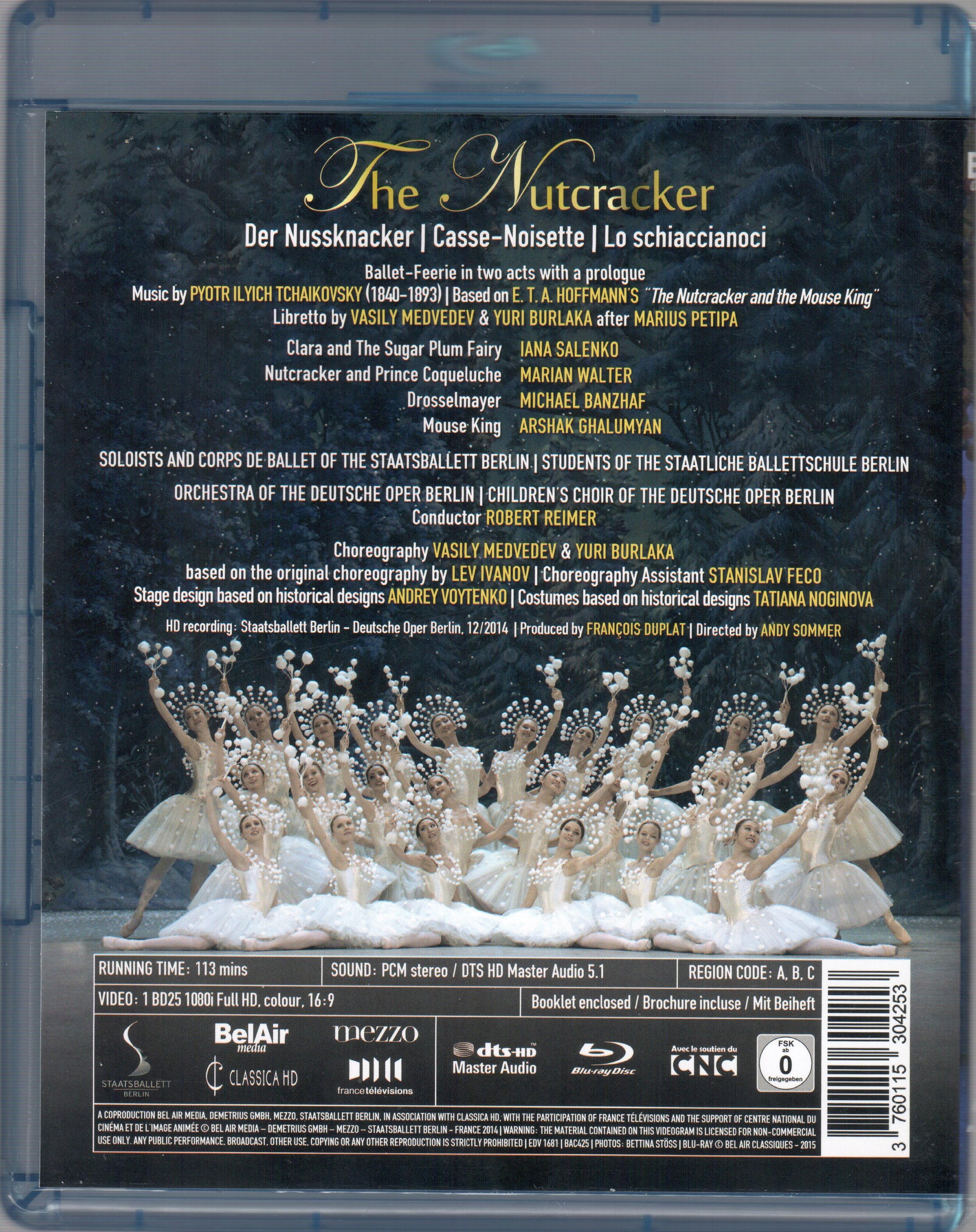

The Nutcracker ballet. Music by to a libretto by Vasily Medvedev and Yuri Burlaka after Marius Petipa. Choreographed by Vasily Medvedev and Yuri Burlaka after Lev Ivanov. This is a reconstruction of the original 1892 Mariinsky historical version. Stars Iana Salenko (Clara/Sugar Plum Fairy), Marian Walter (Nutcracker & Prince Coqueluche), Michael Banzhaf (Drosselmayer); Arshak Ghalumyan (Mouse King), Elena Iseki (Young Clara), and Linus Schmidt (Fritz) supported by soloists and corps de ballet of the Staatsballett Berlin and students of the Ballettschule Berlin. Robert Reimer conducts the Orchestra and Children's Choir of the Deutsche Oper Berlin. Stage design by Andrey Voytenko; costumes by Tatiana Noginova; choreography assistant was Stanislav Feco. Directed for TV by Andy Sommer. Produced by François Duplat. Released 2015, disc has 5.1 dts-HD Master Audio sound. Grade: B+
The world première of The Nutcracker was at the Mariinsky in St. Petersburg shortly before Christmas 1892. Since then many different versions of the ballet have been created. Today there is no "correct" or standard version for the libretto or choreography of The Nutcracker, and there can also be minor differences in what Tchaikovsky music is used.
For subject production, the Berlin State Ballet hired experts in the history of Russian dance in an effort to recreate the libretto, sets, costumes, and choreography of the original show of 1892. The inspiration for the libretto was a story written in German by E.T.A Hoffmann, and most productions are set in a Germany. For this version the family name is Silberhaus and Drosselmayer is a Supreme Court Judge. So it would seem that the setting is probably in Berlin. But the mise-en-scène and some of the dancing might seem a odd to you as the Russian ballet style can differ from we are used to in Western Europe and the US.
The show opens with a bit of romantic social realism as fancy guests pass through the streets on their way to the Silberhaus party. The guests snub street urchins begging for a sweet or treat. Drosselmeyer (Michael Banzhaf) takes pity on the poor kids and gives them some goodies he was taking to the party:
The home of Clara Silberhaus (in Russia, Clara is now usually called "Masha"):
The children's dance. The color pallet is rather restrained compared to most modern productions. But I think this would have been considered quite colorful in 1892:
The adults also dance. Note the gent in pink and gold. Did people really wear clothes like this in 1892? Or was this a fantasy scene then?
The party scene in modern productions tends to be more elaborate and hyperactive than what we see here. Drosselmeyer in Saint Petersburg does a few tricks, but he's mostly a master of ceremonies. He hired dancers portraying a Prince, a Princess, and a Mouse King. Note these costumes as you will see them again later in Clara's dream:
The historically correct (in blackface) Mouse King turns the Prince into a doll, which becomes Clara's present. All this is done quite realistically as Drosselmeyer is just entertaining his friends---he's no wizard:
Young Clara (Elena Iseki) is a bit too old for this, but she loves her ugly doll:
Fritz (Linus Schmidt) is punished for breaking the nutcracker:
The party is over. Everything is transformed in Clara's dream:
Clara hit the Mouse King with her shoe, but the Prince is down!
Drosselmeyer appears---what's happening behind his cape?
Below see the end of the transformation as Clara the woman (Iana Salenko) mourns the loss of Prince Coqueluche (Marian Walter):
But the Prince revives. In the picture below, Clara's white dress washes out when a spotlight turns on and the camera can't handle the increase in illumination:
Clara and the Prince dance:
The Waltz of the Snowflakes. Russian women wear traditional headdresses called kokoshniks, which come in infinite variety. Here the kokoshniks are made with "cotton ball" pom poms, which, I think, are only worn by Russian ballet dancers portraying snowflakes:
The Prince is madly in love since Clara saved him from the Mouse King. He takes her to the Land of Sweets:
They encounter angels on the way. Unfortunately, the angels are behind a scrim that somehow gets into the field-of-focus and mars part of the scene:
Below is a 100% authentic Russian design for a Land of Sweets. The Queen is Clara's mother and there's a swarm of enchanting characters in her retinue. (To see more examples of Russian ballet design, check out the modern [and quite weird] Mariinsky Nutcraker released in 2008.)
In an elaborate mime scene, the Prince relates how Clara saved his life with her shoe. The Queen is so impressed and happy with her son's new sweetheart:
There's a big celebration. Here's a collection of human dolls:
Usually the "coffee" music is danced by an exotic woman supported by men, but here we have a man supported by women:
Mother Ginger with her cute cookie daughters:
The Waltz of the Flowers:
These are the same Prince and Princess costumes we saw earlier at the Silberhaus' party.
Everyone agrees that Clara should be the future Queen! Of course Clara will have to wake up, have breakfast, and then have a piano lesson, etc. But her real home now is elsewhere---with her Prince to whom she can return each evening in her dreams.
We liked the clean, straight-forward telling of this fairy story, which, together with the many roles included for children, make this a good choice for young children. Older girls will also like the mild romance between Clara the woman and the Prince. We quickly got used to the authentic Russian designs, and it's neat to see what this originally looked like. Still, Andy Sommer had difficulty getting the video we deserve. The PQ is a bit soft throughout, judder appears in some scenes, and there are irritating errors like the hot-spot and the visible scrim mentioned in the screenshots. The pas de deux dancing by Salenko and Walter is low-voltage: perhaps something more exciting would be inconsistent with the decision to play this is a fairy story. We reach the conclusion that this is a safe choice for kids that also has appeal to adults who are interested in historical material. Most adults would probably prefer one of the more modern HDVDs of The Nutcracker. We wind up with a B+ grade for this.
Here are YouTube clips:
OR




























